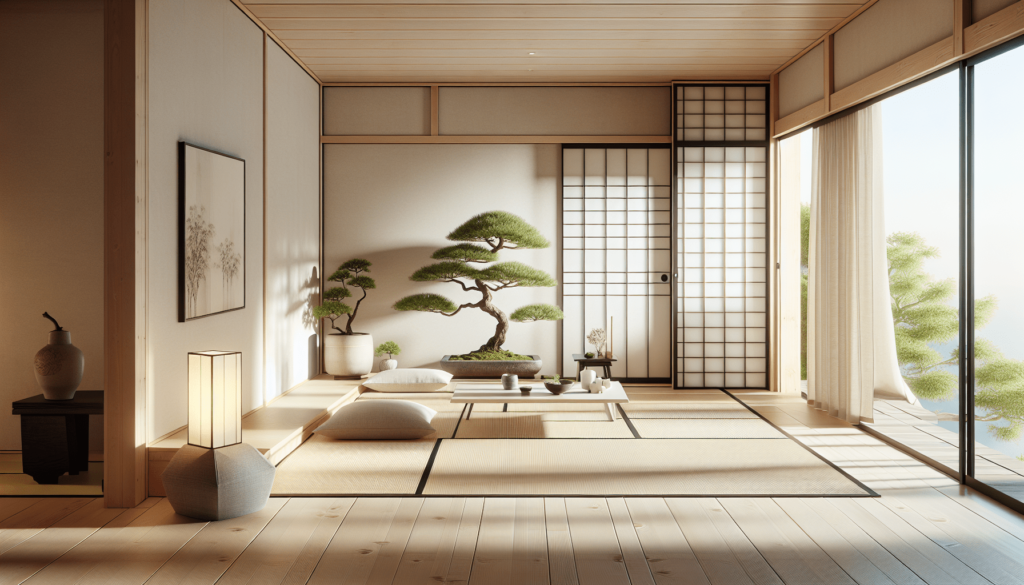Have you ever dreamed of living in a serene, Japanese-style living space? The minimalist aesthetics, natural elements, and the sense of tranquility and balance that come with Japanese interior design can create a peaceful sanctuary in your home. In this article, we will explore the beauty of a tranquil, Japanese-style living space and provide you with tips on how to incorporate these elements into your own home.

The Origins of Japanese Interior Design
Let’s start by taking a look at the origins of Japanese interior design. Rich in tradition and history, Japanese interior design has been influenced by Zen Buddhism, Shintoism, and the principles of wabi-sabi, which focuses on finding beauty in imperfection and simplicity. The design philosophy revolves around creating a harmonious relationship between nature, architecture, and human beings.
Japanese Aesthetics
Japanese interior design is known for its minimalist aesthetics, clean lines, and uncluttered spaces. Each element in a room serves a purpose and contributes to the overall balance and harmony of the space. Natural materials such as wood, bamboo, stone, and paper are commonly used to bring the outside in and create a connection to nature.
Elements of Japanese Interior Design
To create a tranquil Japanese-style living space, it is essential to incorporate the following elements:
Shoji Screens
Shoji screens are traditional Japanese sliding doors made of wooden frames with translucent paper panels. These screens allow natural light to filter through while providing privacy and a sense of openness. Incorporating shoji screens into your home can help create a light and airy atmosphere.
Tatami Mats
Tatami mats are traditional Japanese flooring made of woven rush grass over a rice straw core. These natural mats are soft to the touch and provide a cushioned surface for sitting and sleeping. Adding tatami mats to your living space can bring warmth and a sense of tradition to the room.
Furo
A furo is a traditional Japanese bathtub made of wood or ceramic that is deeper than Western-style tubs. Taking a hot bath in a furo is a relaxing and rejuvenating experience that can help you unwind after a long day. Consider adding a furo to your bathroom for an authentic Japanese spa-like atmosphere.
Ikebana
Ikebana is the Japanese art of flower arranging, which emphasizes harmony, balance, and simplicity. Incorporating ikebana arrangements into your living space can bring a touch of nature indoors and create a sense of beauty and tranquility. You can try your hand at creating your own ikebana arrangements using seasonal flowers and branches.
Fusuma
Fusuma are sliding doors used in traditional Japanese architecture to divide spaces and create privacy. These doors are often decorated with intricate paintings and can be moved to open up or close off different areas of a room. Adding fusuma to your home can help create a sense of versatility and fluidity in your living space.
Color Palette and Textures
When designing a Japanese-style living space, it is essential to pay attention to the color palette and textures used in the room.
Color Palette
Japanese interior design typically features a neutral color palette with earthy tones such as beige, taupe, gray, and off-white. These colors create a calming and harmonious environment that enhances the natural beauty of the space. You can add pops of color with traditional Japanese accents such as red, black, or indigo to create visual interest.
Textures
Textures play a crucial role in Japanese interior design, as they help create depth and visual interest in a space. Incorporate natural materials such as wood, bamboo, stone, and paper to add warmth and texture to your living space. Consider adding shoji screens, tatami mats, and woven textiles to create a tactile and inviting atmosphere.
Furniture and Decor
Furniture and decor in a Japanese-style living space should be simple, functional, and elegant.
Low Furniture
Low furniture such as floor cushions, tatami mats, and low tables are commonly used in Japanese interior design to create a relaxed and intimate seating arrangement. These pieces are designed to bring people closer to the ground and promote a sense of connection to the earth.
Minimalist Decor
Less is more when it comes to decorating a Japanese-style living space. Choose decor that serves a purpose and adds to the overall harmony of the room. Avoid clutter and unnecessary knick-knacks, and opt for natural elements such as bonsai trees, bamboo plants, and ikebana arrangements to enhance the space.
Zen Garden
A small indoor zen garden can bring a sense of Zen tranquility to your living space. Zen gardens typically feature minimalistic arrangements of rocks, sand, and moss that symbolize water and mountains. Spending time in your zen garden can help you relax, meditate, and find inner peace.

Lighting
Lighting plays a significant role in Japanese interior design, as it helps create a sense of ambiance and harmony in a space.
Natural Light
Maximize natural light in your living space by incorporating shoji screens, skylights, and large windows. Natural light creates a sense of openness, brightness, and connection to the outdoors, which is essential in Japanese interior design.
Warm Lighting
In addition to natural light, warm artificial lighting can help create a cozy and inviting atmosphere in your home. Use soft, diffused lighting sources such as paper lanterns, wall sconces, and floor lamps to add warmth and ambiance to your living space.
Creating a Tranquil Japanese-Style Living Space
To create a tranquil, Japanese-style living space in your home, follow these simple tips:
- Embrace minimalism: Declutter your space and focus on essential elements that contribute to a sense of balance and harmony.
- Bring nature indoors: Incorporate natural materials, plants, and elements of the outdoors to create a connection to nature.
- Choose a neutral color palette: Stick to earthy tones and neutral colors to create a calming and harmonious environment.
- Add traditional Japanese elements: Incorporate shoji screens, tatami mats, ikebana arrangements, and other traditional Japanese elements to enhance the authenticity of your living space.
- Create a sense of tranquility: Use lighting, furniture, and decor to create a peaceful and serene atmosphere that promotes relaxation and well-being.
By incorporating these elements and following these tips, you can transform your living space into a tranquil, Japanese-style sanctuary that promotes peace, balance, and harmony. Experiment with different elements and designs to create a space that reflects your personality and brings you joy and tranquility. Enjoy the beauty of a tranquil, Japanese-style living space in your own home!

